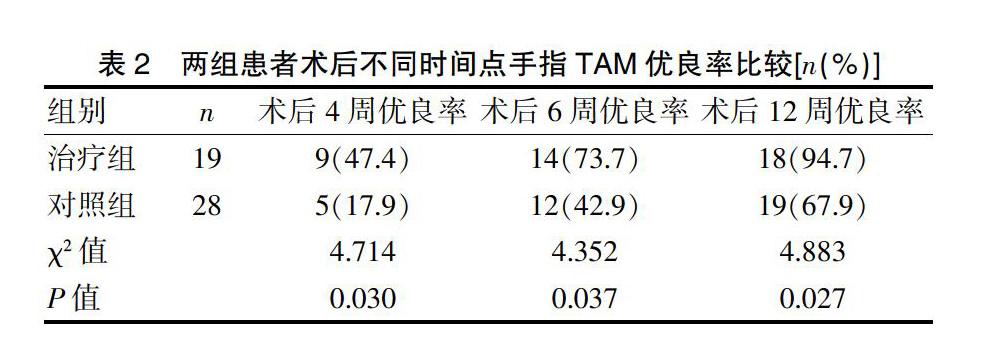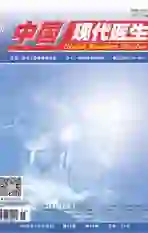动力型支具结合早期康复锻炼在屈指肌腱Ⅱ区修复术后的临床疗效观察
2020-08-04杨家全陈坤强周欢斌
杨家全 陈坤强 周欢斌


[摘要] 目的 觀察动力型支具结合早期功能锻炼在屈指肌腱Ⅱ区断裂修复术后应用对手指功能恢复的临床疗效。 方法 选取我院2017年6月~2018年10月期间屈指肌腱Ⅱ区断裂并行手术修复的47例(共81指)患者,按照来院先后随机分成治疗组(19例,共34指)和对照组(28例,47指)。治疗组肌腱修复术后给予动力型支具固定,并在术后第1天开始在支具保护下行手指主动伸指和被动屈伸手指锻炼,对照组给予静力型支具固定,两组支具均固定在相同的位置。两组患者均支具固定至术后3周,并在术后4周、6周、12周按TAM法评定手指总主动活动度。 结果 通过TAM法评定优良率,结果显示治疗组术后4周、6周、12周TAM优良率均明显优于对照组(P<0.05),这个优势于术后4周、6周更为明显。 结论 动力型支具结合早期功能锻炼在屈指肌腱Ⅱ区断裂术后应用能较早的获得较好的手指主动屈伸活动度,利于屈指肌腱Ⅱ区损伤术后早期康复。
[关键词] 屈肌腱修复;Ⅱ区;动力矫形器;功能恢复
[中图分类号] R473.6 [文献标识码] B [文章编号] 1673-9701(2020)15-0080-03
Observation of the clinical effect of dynamic orthosis combined with early rehabilitation exercise after zone Ⅱ flexor tendon repair
YANG Jiaquan CHEN Kunqiang ZHOU Huanbin LIAO Jianping
Department of Orthopaedics, Jiujiang First People's Hospital in Jiangxi Province, Jiujiang 332000, China
[Abstract] Objective To observe the clinical effect of dynamic orthosis combined with early function exercise on the recovery of finger function after repair of the flexor tendon zone Ⅱ rupture. Methods A total of 47 patients(81 fingers) who underwent surgical repair of the flexor tendon zone Ⅱrupture in our hospital from June 2017 to October 2018 were randomly divided into treatment group(19 patients, 34 fingers) and control group(28 patients, 47 fingers). The treatment group was given a dynamic orthosis fixation after tendon repair, and on the first day after surgery, the fingers were actively and passively extended and flexed under the protection of the orthosis. The control group was given static orthosis. Both orthoses were fixed in the same position. Both groups of patients were fixed by orthosis to 3 weeks after operation, and the total active finger activity was evaluated by TAM method at 4 weeks, 6 weeks, and 12 weeks after operation. Results The excellent and good rate was evaluated by TAM method. The results showed that the excellent and good rate of TAM in the treatment group was significantly better than that in the control group at 4 weeks, 6 weeks, and 12 weeks after operation(P<0.05), and this advantage was more obvious at 4 and 6 weeks after surgery. Conclusion The application of dynamic orthosis combined with early function exercise after the surgery for the flexor tendon zone Ⅱ rupture can obtain better active flexion and extension of the fingers earlier, which is beneficial to early rehabilitation after injury of flexor tendon zone Ⅱ.
在修复肌腱时,本文使用了改良Kessler法加肌腱周围连续锁边缝合法。因为大量的研究表明,此方法的缝合强度足以进行早期主动运动,并减少肌腱粘连、断裂等并发症[11-13]。本研究中47例患者采用此缝合方法,未出现肌腱再断裂病例。
临床上被动锻炼应遵循过程要缓慢、幅度要充分的原则[14]。动力型支具不是无限制的活动,是采用动静结合的方法。因为关节松动技术作用于关节周围纤维组织时,纤维组织被拉长,需达到一定时间后关节周围纤维组织由弹性延长才会转变为塑性延长,所以功能锻炼后仍需结合静态制动,两者协同作用,才能提高疗效、缩短治疗时间[15-17]。同时,我们意识到,动力型支具牵拉手指被动屈曲活动时,屈曲活动幅度不够,难以屈曲到最大屈曲活动度,这一表现在远指间关节上更为明显。所以我们结合了医生帮助,尽量将患者掌指关节、近指间关节、远指间关节被动屈曲到最大活动度,从而补充了动力型支具的不足,这样是本研究中治疗组获得良好的临床疗效一个重要原因。
综上所述,本研究结果表明,动力型支具结合早期功能锻炼,在屈指肌腱Ⅱ区断裂术后应用能较早的获得良好的手指主动屈伸活动度,利于屈指肌腱Ⅱ区断裂术后早期功能恢复。
[参考文献]
[1] Chesney A,Chauhan A,Kattan A,et al. Systematic review of flexor tendon rehabilitation protocols in zone Ⅱ of the hand[J]. Plast Reconstr Surg,2011,127:1583-1592.
[2] Wong JKF,Lui YH,Kapacee Z,et al. The cellular biology of flexor tendon adhesion formation:An old problem in a new paradigm[J]. Am J Pathol,2009,175(5):1938-1951.
[3] Tang JB. Wide-awake primary flexor tendon repair,tenolysis,and tendon transfer[J]. Clin Orthop Surg,2015, 7(3):275-281.
[4] Kannas S,Jeardeau TA,Bishop AT. Rehabilitation following zone Ⅱ flexor tendon repairs[J]. Tech Hand Up Extrem Surg,2015,19(1):10-12.
[5] 胡燕青,蔣海,李棋,等. 不同肌腱缝合方法的生物力学比较研究[J]. 中国修复重建外科杂志,2017,31(10):1208-1213.
[6] Geetha K,Hariharan NC,Mohan J. Early ultrasound therapy for rehabilitation after zone Ⅱ flexor tendon repair[J].Indian J Plast Surg,2014,47(1):85-91.
[7] Kubota H,Manske PR,Aoki M,et al. Effect of motion and tension on injured flexor tendons in chickens[J]. J Hand Surg Am,1996,21(3)456-463.
[8] Wada A,Kubota H,Akiyama T,et al. Effect of absorbable polydioxanone flexor tendon repair and restricted active mobilization in a canine model[J]. J Hand Surg Am,2001,26(3):398-406.
[9] Christopher SK,Jared B,Nader P. Postsurgical rehabilitation of flexor tendon injuries[J]. J Hand Surg Am,2019,44(8):680-686.
[10] 李连楚. 使用动力型支具时手指肌腱的力学变化分析[J].中华物理医学与康复杂志,2014,36(10):737-739.
[11] Dy CJ,Soria A,Ma Y,et al. Complications after flexor tendon repair:A systematic review and meta-analysis[J]. J Hand Surg Am,2012,37(3):543-551.
[12] Das KP,Datta NK,Chowdhury RM,et al. Outcome of early active mobilization in flexor tendon repair in zone Ⅱ in hand[J]. Mymensingh Med J,2014,23(3):503-511.
[13] 程杰,王继宏,樊东升,等. 被动功能锻炼预防屈肌腱粘连的实验研究[J]. 中华手外科杂志,2018,34(5):371-374.
[14] Jordan MC,Schmitt V,Jansen H,et al. Biomechanical analysis of the modified kessler,lahey,adelaide and becker sutures for flexor tendon repair[J]. J Hand Surg Am,2015,40(9):1812-1817.
[15] 曹曼林,马峥,白跃宏. 矫形器联合关节松动术治疗指屈肌腱粘连的疗效观察[J]. 中华物理医学与康复杂志,2013,35(8):654-656.
[16] 程凌,胡思彦. 青藤碱(正清风)定点介入治疗配合关节松动术治疗膝关节炎的临床疗效观察[J]. 当代医学,2019,25(24):154-155.
[17] 谢钢,姚弘毅,王琳,等. 关节松动术联合体外冲击波治疗肩周炎的疗效[J]. 中国医学创新,2019,16(26):28-31.
(收稿日期:2019-12-31)
